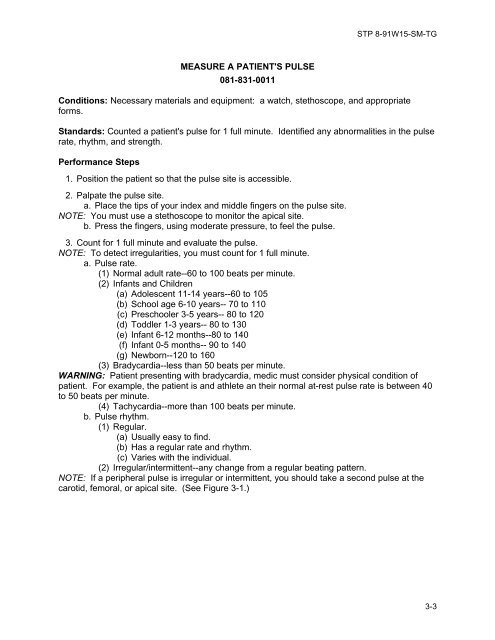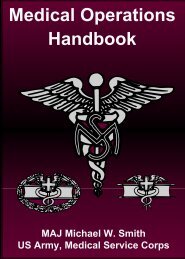- Page 1 and 2: STP 8-91W15-SM-TG SOLDIER’S MANUA
- Page 3 and 4: STP 8-91W15-SM-TG Chapter 3. MOS/Sk
- Page 5 and 6: STP 8-91W15-SM-TG Subject Area 10:
- Page 7 and 8: STP 8-91W15-SM-TG PREFACE This publ
- Page 9 and 10: STP 8-91W15-SM-TG soldiers do not h
- Page 11 and 12: MOS 91W Health Care Specialist CARE
- Page 13 and 14: STP 8-91W15-SM-TG Prepare the soldi
- Page 15 and 16: STP 8-91W15-SM-TG AIT UNIT BNCOC Ad
- Page 17 and 18: STP 8-91W15-SM-TG 2-3. Part One, Se
- Page 19 and 20: STP 8-91W15-SM-TG CRITICAL TASKS Su
- Page 21 and 22: STP 8-91W15-SM-TG CRITICAL TASKS Su
- Page 23 and 24: STP 8-91W15-SM-TG CRITICAL TASKS Su
- Page 25: STP 8-91W15-SM-TG Performance Steps
- Page 29 and 30: STP 8-91W15-SM-TG MEASURE A PATIENT
- Page 31 and 32: STP 8-91W15-SM-TG Performance Measu
- Page 33 and 34: STP 8-91W15-SM-TG Performance Steps
- Page 35 and 36: STP 8-91W15-SM-TG MEASURE A PATIENT
- Page 37 and 38: STP 8-91W15-SM-TG Subject Area 2: E
- Page 39 and 40: STP 8-91W15-SM-TG CLEAR AN UPPER AI
- Page 41 and 42: STP 8-91W15-SM-TG Performance Steps
- Page 43 and 44: STP 8-91W15-SM-TG Performance Steps
- Page 45 and 46: STP 8-91W15-SM-TG References Requir
- Page 47 and 48: STP 8-91W15-SM-TG Performance Steps
- Page 49 and 50: STP 8-91W15-SM-TG Performance Measu
- Page 51 and 52: STP 8-91W15-SM-TG Performance Steps
- Page 53 and 54: STP 8-91W15-SM-TG PLACE A PATIENT O
- Page 55 and 56: STP 8-91W15-SM-TG MANAGE CARDIAC AR
- Page 57 and 58: STP 8-91W15-SM-TG Performance Measu
- Page 59 and 60: STP 8-91W15-SM-TG Performance Steps
- Page 61 and 62: STP 8-91W15-SM-TG Performance Steps
- Page 63 and 64: STP 8-91W15-SM-TG INITIATE A FIELD
- Page 65 and 66: STP 8-91W15-SM-TG APPLY RESTRAINING
- Page 67 and 68: STP 8-91W15-SM-TG Performance Steps
- Page 69 and 70: STP 8-91W15-SM-TG Performance Steps
- Page 71 and 72: STP 8-91W15-SM-TG ESTABLISH A STERI
- Page 73 and 74: STP 8-91W15-SM-TG CHANGE A STERILE
- Page 75 and 76: STP 8-91W15-SM-TG Performance Steps
- Page 77 and 78:
STP 8-91W15-SM-TG PERFORM A WOUND I
- Page 79 and 80:
STP 8-91W15-SM-TG Performance Measu
- Page 81 and 82:
STP 8-91W15-SM-TG Performance Steps
- Page 83 and 84:
STP 8-91W15-SM-TG Performance Measu
- Page 85 and 86:
STP 8-91W15-SM-TG Performance Steps
- Page 87 and 88:
STP 8-91W15-SM-TG DOCUMENT PATIENT
- Page 89 and 90:
STP 8-91W15-SM-TG PERFORM PATIENT H
- Page 91 and 92:
STP 8-91W15-SM-TG Performance Steps
- Page 93 and 94:
STP 8-91W15-SM-TG Performance Measu
- Page 95 and 96:
STP 8-91W15-SM-TG Performance Steps
- Page 97 and 98:
STP 8-91W15-SM-TG Performance Steps
- Page 99 and 100:
STP 8-91W15-SM-TG b. Calculate the
- Page 101 and 102:
STP 8-91W15-SM-TG Subject Area 4: R
- Page 103 and 104:
STP 8-91W15-SM-TG SET UP AN OXYGEN
- Page 105 and 106:
STP 8-91W15-SM-TG Performance Steps
- Page 107 and 108:
STP 8-91W15-SM-TG Performance Steps
- Page 109 and 110:
STP 8-91W15-SM-TG INSERT A NASOPHAR
- Page 111 and 112:
STP 8-91W15-SM-TG ADMINISTER OXYGEN
- Page 113 and 114:
STP 8-91W15-SM-TG Performance Measu
- Page 115 and 116:
STP 8-91W15-SM-TG Performance Steps
- Page 117 and 118:
STP 8-91W15-SM-TG Performance Steps
- Page 119 and 120:
STP 8-91W15-SM-TG PERFORM NEEDLE CH
- Page 121 and 122:
STP 8-91W15-SM-TG Performance Measu
- Page 123 and 124:
STP 8-91W15-SM-TG Performance Steps
- Page 125 and 126:
STP 8-91W15-SM-TG Performance Steps
- Page 127 and 128:
STP 8-91W15-SM-TG INITIATE AN INTRA
- Page 129 and 130:
STP 8-91W15-SM-TG Performance Steps
- Page 131 and 132:
STP 8-91W15-SM-TG Performance Measu
- Page 133 and 134:
STP 8-91W15-SM-TG Performance Steps
- Page 135 and 136:
STP 8-91W15-SM-TG Performance Steps
- Page 137 and 138:
STP 8-91W15-SM-TG INITIATE A SALINE
- Page 139 and 140:
STP 8-91W15-SM-TG Performance Steps
- Page 141 and 142:
STP 8-91W15-SM-TG Subject Area 6: C
- Page 143 and 144:
STP 8-91W15-SM-TG Evaluation Guidan
- Page 145 and 146:
STP 8-91W15-SM-TG Performance Steps
- Page 147 and 148:
STP 8-91W15-SM-TG Performance Steps
- Page 149 and 150:
STP 8-91W15-SM-TG Performance Steps
- Page 151 and 152:
STP 8-91W15-SM-TG TREAT A CASUALTY
- Page 153 and 154:
STP 8-91W15-SM-TG Performance Steps
- Page 155 and 156:
STP 8-91W15-SM-TG TREAT A CASUALTY
- Page 157 and 158:
STP 8-91W15-SM-TG Evaluation Prepar
- Page 159 and 160:
STP 8-91W15-SM-TG Performance Steps
- Page 161 and 162:
STP 8-91W15-SM-TG Evaluation Guidan
- Page 163 and 164:
STP 8-91W15-SM-TG Performance Steps
- Page 165 and 166:
STP 8-91W15-SM-TG Performance Steps
- Page 167 and 168:
STP 8-91W15-SM-TG PROVIDE CARE FOR
- Page 169 and 170:
STP 8-91W15-SM-TG Performance Steps
- Page 171 and 172:
STP 8-91W15-SM-TG Performance Steps
- Page 173 and 174:
STP 8-91W15-SM-TG Performance Measu
- Page 175 and 176:
STP 8-91W15-SM-TG Performance Steps
- Page 177 and 178:
STP 8-91W15-SM-TG TREAT A DIABETIC
- Page 179 and 180:
STP 8-91W15-SM-TG References Requir
- Page 181 and 182:
STP 8-91W15-SM-TG Performance Steps
- Page 183 and 184:
STP 8-91W15-SM-TG Performance Steps
- Page 185 and 186:
STP 8-91W15-SM-TG Evaluation Guidan
- Page 187 and 188:
STP 8-91W15-SM-TG Performance Steps
- Page 189 and 190:
STP 8-91W15-SM-TG Performance Steps
- Page 191 and 192:
STP 8-91W15-SM-TG Performance Steps
- Page 193 and 194:
STP 8-91W15-SM-TG Performance Steps
- Page 195 and 196:
STP 8-91W15-SM-TG Performance Steps
- Page 197 and 198:
STP 8-91W15-SM-TG Subject Area 7: E
- Page 199 and 200:
STP 8-91W15-SM-TG TREAT FOREIGN BOD
- Page 201 and 202:
STP 8-91W15-SM-TG TREAT LACERATIONS
- Page 203 and 204:
STP 8-91W15-SM-TG References Requir
- Page 205 and 206:
STP 8-91W15-SM-TG Performance Steps
- Page 207 and 208:
STP 8-91W15-SM-TG Performance Measu
- Page 209 and 210:
STP 8-91W15-SM-TG Performance Steps
- Page 211 and 212:
STP 8-91W15-SM-TG Performance Steps
- Page 213 and 214:
STP 8-91W15-SM-TG IMMOBILIZE A SUSP
- Page 215 and 216:
STP 8-91W15-SM-TG Performance Measu
- Page 217 and 218:
STP 8-91W15-SM-TG Performance Steps
- Page 219 and 220:
STP 8-91W15-SM-TG TRANSPORT A CASUA
- Page 221 and 222:
STP 8-91W15-SM-TG Performance Steps
- Page 223 and 224:
STP 8-91W15-SM-TG Brief soldier: To
- Page 225 and 226:
STP 8-91W15-SM-TG Performance Steps
- Page 227 and 228:
STP 8-91W15-SM-TG Performance Steps
- Page 229 and 230:
STP 8-91W15-SM-TG Performance Steps
- Page 231 and 232:
STP 8-91W15-SM-TG PROVIDE BASIC EME
- Page 233 and 234:
STP 8-91W15-SM-TG Subject Area 9: E
- Page 235 and 236:
STP 8-91W15-SM-TG Performance Measu
- Page 237 and 238:
STP 8-91W15-SM-TG Performance Steps
- Page 239 and 240:
STP 8-91W15-SM-TG Evaluation Guidan
- Page 241 and 242:
STP 8-91W15-SM-TG Performance Steps
- Page 243 and 244:
STP 8-91W15-SM-TG Performance Steps
- Page 245 and 246:
STP 8-91W15-SM-TG Performance Steps
- Page 247 and 248:
STP 8-91W15-SM-TG Performance Steps
- Page 249 and 250:
STP 8-91W15-SM-TG Subject Area 10:
- Page 251 and 252:
STP 8-91W15-SM-TG Performance Steps
- Page 253 and 254:
STP 8-91W15-SM-TG TREAT A BLOOD AGE
- Page 255 and 256:
STP 8-91W15-SM-TG TREAT A CHOKING A
- Page 257 and 258:
STP 8-91W15-SM-TG TREAT A BLISTER A
- Page 259 and 260:
STP 8-91W15-SM-TG Performance Measu
- Page 261 and 262:
STP 8-91W15-SM-TG Performance Steps
- Page 263 and 264:
STP 8-91W15-SM-TG Performance Steps
- Page 265 and 266:
STP 8-91W15-SM-TG Performance Steps
- Page 267 and 268:
STP 8-91W15-SM-TG Subject Area 11:
- Page 269 and 270:
STP 8-91W15-SM-TG APPLY PNEUMATIC A
- Page 271 and 272:
STP 8-91W15-SM-TG Performance Steps
- Page 273 and 274:
STP 8-91W15-SM-TG Subject Area 12:
- Page 275 and 276:
STP 8-91W15-SM-TG Performance Steps
- Page 277 and 278:
STP 8-91W15-SM-TG Performance Steps
- Page 279 and 280:
STP 8-91W15-SM-TG Subject Area 13:
- Page 281 and 282:
STP 8-91W15-SM-TG Performance Measu
- Page 283 and 284:
STP 8-91W15-SM-TG Performance Steps
- Page 285 and 286:
STP 8-91W15-SM-TG Subject Area 14:
- Page 287 and 288:
STP 8-91W15-SM-TG Performance Steps
- Page 289 and 290:
STP 8-91W15-SM-TG Performance Steps
- Page 291 and 292:
STP 8-91W15-SM-TG Evaluation Prepar
- Page 293 and 294:
STP 8-91W15-SM-TG Performance Steps
- Page 295 and 296:
STP 8-91W15-SM-TG TRIAGE CASUALTIES
- Page 297 and 298:
STP 8-91W15-SM-TG Performance Steps
- Page 299 and 300:
STP 8-91W15-SM-TG TRIAGE CASUALTIES
- Page 301 and 302:
STP 8-91W15-SM-TG LOAD CASUALTIES O
- Page 303 and 304:
STP 8-91W15-SM-TG Performance Steps
- Page 305 and 306:
STP 8-91W15-SM-TG Performance Steps
- Page 307 and 308:
STP 8-91W15-SM-TG Performance Steps
- Page 309 and 310:
STP 8-91W15-SM-TG LOAD CASUALTIES O
- Page 311 and 312:
STP 8-91W15-SM-TG Evaluation Guidan
- Page 313 and 314:
STP 8-91W15-SM-TG Evaluation Guidan
- Page 315 and 316:
STP 8-91W15-SM-TG Performance Steps
- Page 317 and 318:
STP 8-91W15-SM-TG Subject Area 15:
- Page 319 and 320:
STP 8-91W15-SM-TG Performance Steps
- Page 321 and 322:
STP 8-91W15-SM-TG Performance Measu
- Page 323 and 324:
STP 8-91W15-SM-TG Performance Steps
- Page 325 and 326:
STP 8-91W15-SM-TG Performance Steps
- Page 327 and 328:
STP 8-91W15-SM-TG ADMINISTER MORPHI
- Page 329 and 330:
STP 8-91W15-SM-TG ADMINISTER ORAL M
- Page 331 and 332:
STP 8-91W15-SM-TG Performance Measu
- Page 333 and 334:
STP 8-91W15-SM-TG Performance Steps
- Page 335 and 336:
STP 8-91W15-SM-TG ADMINISTER RECTAL
- Page 337 and 338:
STP 8-91W15-SM-TG Performance Steps
- Page 339 and 340:
STP 8-91W15-SM-TG Performance Steps
- Page 341 and 342:
STP 8-91W15-SM-TG Subject Area 16:
- Page 343 and 344:
STP 8-91W15-SM-TG Skill Level 2 Sub
- Page 345 and 346:
STP 8-91W15-SM-TG Performance Measu
- Page 347 and 348:
STP 8-91W15-SM-TG Performance Steps
- Page 349 and 350:
STP 8-91W15-SM-TG PROVIDE NURSING C
- Page 351 and 352:
STP 8-91W15-SM-TG Performance Steps
- Page 353 and 354:
STP 8-91W15-SM-TG Performance Steps
- Page 355 and 356:
STP 8-91W15-SM-TG Performance Measu
- Page 357 and 358:
STP 8-91W15-SM-TG Performance Steps
- Page 359 and 360:
STP 8-91W15-SM-TG Performance Steps
- Page 361 and 362:
STP 8-91W15-SM-TG Performance Steps
- Page 363 and 364:
STP 8-91W15-SM-TG Performance Steps
- Page 365 and 366:
STP 8-91W15-SM-TG Performance Measu
- Page 367 and 368:
STP 8-91W15-SM-TG Performance Steps
- Page 369 and 370:
STP 8-91W15-SM-TG Performance Steps
- Page 371 and 372:
STP 8-91W15-SM-TG PERFORM A NEUROLO
- Page 373 and 374:
STP 8-91W15-SM-TG Performance Steps
- Page 375 and 376:
STP 8-91W15-SM-TG ADMINISTER BLOOD
- Page 377 and 378:
STP 8-91W15-SM-TG Performance Steps
- Page 379 and 380:
STP 8-91W15-SM-TG Evaluation Guidan
- Page 381 and 382:
STP 8-91W15-SM-TG Performance Steps
- Page 383 and 384:
STP 8-91W15-SM-TG SUTURE A MINOR LA
- Page 385 and 386:
STP 8-91W15-SM-TG Performance Steps
- Page 387 and 388:
STP 8-91W15-SM-TG A-2
- Page 389 and 390:
STP 8-91W15-SM-TG A-4
- Page 391 and 392:
STP 8-91W15-SM-TG A-6
- Page 393 and 394:
STP 8-91W15-SM-TG A-8
- Page 395 and 396:
STP 8-91W15-SM-TG A-10
- Page 397 and 398:
STP 8-91W15-SM-TG Calculation of Do
- Page 399 and 400:
STP 8-91W15-SM-TG ABBREVIATIONS ac
- Page 401 and 402:
STP 8-91W15-SM-TG COPD CPR chronic
- Page 403 and 404:
STP 8-91W15-SM-TG NPO PA PASG PEA p
- Page 405 and 406:
STP 8-91W15-SM-TG REFERENCES New re
- Page 407:
STP 8-91W15-SM-TG 10 October 2001 B




